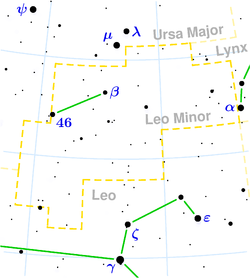
Leo Minorids
Encyclopedia

Meteor shower
A meteor shower is a celestial event in which a number of meteors are observed to radiate from one point in the night sky. These meteors are caused by streams of cosmic debris called meteoroids entering Earth's atmosphere at extremely high speeds on parallel trajectories. Most meteors are smaller...
that takes place from October 19 till October 27 each year. With a weak moon the meteor shower may be visible with the naked eye, however this meteor shower is best observed only from the Northern Hemisphere
Northern Hemisphere
The Northern Hemisphere is the half of a planet that is north of its equator—the word hemisphere literally means “half sphere”. It is also that half of the celestial sphere north of the celestial equator...
with telescopic plotting. This meteor shower is linked to comet C/1739 K1 an radiates from the contellation Leo Minor
Leo Minor
Leo Minor is a small and faint constellation. Its name means "the smaller lion", in contrast to Leo, the larger lion. Its brightest stars form a rough triangle, and it lies between the larger and more recognizable Ursa Major and Leo...
, which is a faint constellation north of Leo
Leo (constellation)
Leo is one of the constellations of the zodiac. Its name is Latin for lion. Its symbol is . Leo lies between dim Cancer to the west and Virgo to the east.-Stars:...
. The meteor shower often only produces 2 meteors an hour.
| Year | Leo Minorids active between | Peak of shower |
|---|---|---|
| 2008 | Oct 17 – 27 | October 24 (ZHRmax Zenithal Hourly Rate In astronomy, the Zenithal Hourly Rate of a meteor shower is the number of meteors a single observer would see in one hour under a clear, dark sky if the radiant of the shower were at the zenith... 2) |
| 2009 | Oct 19 – 27 | October 23 predicted (ZHRmax Zenithal Hourly Rate In astronomy, the Zenithal Hourly Rate of a meteor shower is the number of meteors a single observer would see in one hour under a clear, dark sky if the radiant of the shower were at the zenith... 2) |

